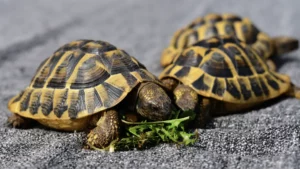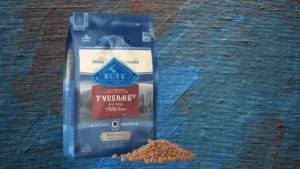What Should You Feed Your Crested Gecko To Keep it Healthy?
Unsure what to Feed Your Crested Gecko? Learn the essential diet for these amazing reptiles to keep them happy and healthy!
Correlophus Ciliatus, or the crested gecko, fondly referred to as Crestie by pet owners, is among the most popular pets worldwide. If you want your crested gecko to be healthy, you need to feed them right. Now, you might wonder, what do crested geckos eat? They usually feed on a balanced combination of commercial crested gecko food, insects, fruits, and vegetables.
Geckos on the Hunt: A Look at Their Wild Diet
Geckos, those fascinating little reptiles with sticky toes and bulging eyes, are found all over the world in diverse habitats. But what fuels these curious creatures in the wild? Their diet is surprisingly varied, reflecting their opportunistic hunting strategies and the abundance of prey in their surroundings. Let’s delve into the top 10 things geckos typically munch on in their natural environments:
- Insects: This forms the bulk of most gecko diets, with crickets, grasshoppers, beetles, flies, and moths being popular choices. Their long, sticky tongues make them adept at snatching up unsuspecting prey.
- Spiders: Geckos are not afraid to take down these eight-legged wonders. Their agility and quick reflexes allow them to overcome even venomous spider species.
- Worms: Earthworms and other soft-bodied worms are a nutritious and readily available food source for many geckos, especially those that hunt on the ground.
- Small Lizards and Snakes: While not their primary target, some larger gecko species might occasionally prey on smaller lizards or even young snakes, adding variety to their diet.
- Small Rodents and Mammals: Geckos with the size and strength, like Tokay geckos, might include small mice, shrews, or even baby rats in their meals.
- Eggs: Gecko meals aren’t limited to live prey. They might readily consume the eggs of other reptiles and birds, including their own species, if the opportunity arises.
- Fruits and Berries: Not all geckos are strictly carnivorous. Some, like the Crested Gecko, are omnivores and supplement their insect diet with fruits and berries, especially in seasons with lower insect abundance.
- Nectar: Certain gecko species, particularly those adapted to drier environments, might lick nectar from flowers to supplement their water intake and obtain additional nutrients.
- Pollen: Like nectar, some geckos might consume pollen from flowers, providing them with essential vitamins and minerals.
- Carrion: While not their preferred choice, some gecko species might scavenge on the carcasses of dead animals if live prey is scarce.
This list showcases the diverse dietary strategies of geckos in the wild. From being skilled insectivores to opportunistic omnivores, these fascinating reptiles have adapted their eating habits to thrive in various environments across the globe.
Feeding Your Geckos Right: A Look at the Captive Diet
Bringing a gecko into your home as a pet comes with the responsibility of providing it with proper nutrition. Unlike their diverse diets in the wild, captive geckos rely on you to fulfill their specific dietary needs. Here’s a breakdown of the key points to consider when creating a balanced and healthy diet for your captive gecko:
- Live Insects: The foundation of most captive gecko diets remains live insects, mirroring their natural preference for moving prey. Popular choices include crickets, dubia roaches, mealworms, and superworms.
- Variety is Key: Don’t stick to one type of insect! Offer a variety of feeder insects to ensure your gecko receives a balanced range of nutrients.
- Size Matters: Always choose insects that are no larger than the width of your gecko’s head to avoid choking hazards or digestion issues.
- Gut Loading: Before feeding live insects to your gecko, “gut load” them with nutritious foods like leafy greens and commercially available gut-loading formulas. This ensures your gecko gets essential vitamins and minerals indirectly.
- Supplementation: Dusting feeder insects with calcium powder and a multivitamin supplement a few times a week is crucial to prevent nutritional deficiencies in your gecko.
- Freshwater: Provide a clean and readily accessible source of fresh water daily. Some geckos might drink from a shallow dish, while others may prefer licking water droplets from the enclosure walls.
- Species-Specific Needs: Different gecko species have varying dietary requirements. Research the specific needs of your gecko breed to ensure you’re providing the appropriate diet.
- Age-Specific Feeding: Adjust feeding frequency and portion size based on your gecko’s age. Young geckos usually require more frequent meals than adults.
- Monitor Weight: Regularly monitor your gecko’s weight to ensure they are maintaining a healthy body condition. Overweight or underweight geckos might need adjustments to their diet.
- Avoid Certain Foods: Steer clear of offering sugary treats, fatty foods, or processed diets not intended for reptiles. These can be harmful to your gecko’s health.
- Frugivore and Omnivore Diets: Certain gecko species, like Crested Geckos, have omnivorous or frugivorous diets. These geckos may require specialized commercial food mixes, fresh fruits, and vegetables alongside insects.
- Hygiene is Important: Always wash your hands thoroughly before handling food items and your gecko’s enclosure to maintain good hygiene and prevent the spread of bacteria.
- Observe Feeding Behavior: Pay close attention to your gecko’s feeding behavior. If they’re losing weight or showing signs of disinterest in food, consult a veterinarian to rule out any underlying health issues.
- Seek Professional Advice: If you have any doubts or concerns about your gecko’s diet, don’t hesitate to seek guidance from a qualified reptile veterinarian or experienced gecko breeder.
By following these guidelines and doing your research on your specific gecko breed, you can ensure your pet thrives on a healthy and balanced diet in captivity. Remember, proper nutrition is essential for a long and happy life for your gecko companion.
Sweet Treats: Safe Fruits for Your Crested Gecko
Crested geckos, with their vibrant colors and adorable eyelashes, are popular choices for pet reptiles. While their main diet consists of insects and commercially prepared crested gecko diets (CGDs), you can occasionally offer them fruits as a delightful and nutritious treat. However, it’s crucial to choose the right fruits and offer them in moderation to avoid any health problems.
Here’s a list of safe and healthy fruits you can occasionally offer your crested gecko:
- Mango: This juicy fruit is rich in vitamins A and C, essential for vision and immune function. However, remove the pit and skin before offering a small piece.
- Pear: Chopped, peeled pear provides hydration and essential fiber for your gecko. Limit portions due to its higher sugar content.
- Banana: While a good source of potassium, bananas are high in sugar. Mash a tiny amount with other fruits to create a sweet treat, but avoid offering it too often.
- Grapes: Seedless grapes, cut into small pieces, can be an occasional treat for your gecko. However, be mindful of their high sugar content and offer them sparingly.
- Fig: Figs are a good source of calcium and fiber, but their sticky texture might be challenging for some geckos to manage. Offer a tiny piece occasionally, diced or mashed.
- Apricot: Rich in vitamins A and C, apricots can be offered in small, diced pieces with the skin and pit removed.
- Strawberry: These tiny fruits are packed with antioxidants and can be offered whole or chopped into smaller pieces. However, limit their frequency due to their high sugar content
- Watermelon: A refreshing and hydrating treat, watermelon can be offered in small, seedless pieces. Avoid the rind as it’s difficult to digest.
- Blueberry: Blueberries are rich in antioxidants and can be offered whole or mashed. Due to their small size, they are generally safe for crested geckos.
- Kiwi: This vitamin C-rich fruit can be offered in small, diced pieces with the skin removed. However, its tartness might not be appealing to all geckos.
Remember:
- Always wash fruits thoroughly before offering them to your gecko.
- Cut fruits into small, bite-sized pieces to prevent choking hazards.
- Limit fruits to no more than twice a week and offer them as treats, not as a dietary staple.
- Monitor your gecko’s eating habits and avoid offering fruits if they show any signs of digestive discomfort.
By following these guidelines and offering fruits in moderation, you can ensure your crested gecko enjoys a healthy and balanced diet that includes occasional sweet treats.
Premixed Powders and Granules: A Potential Alternative?
In various fields, from food preparation to medicine, premixed powders and granules are gaining popularity as convenient alternatives to traditional ingredients. However, before deciding if they are the right choice for you, it’s crucial to consider their advantages and disadvantages:
Potential Advantages:
- Convenience: Premixed options eliminate the need for measuring and combining individual ingredients, saving time and effort.
- Standardized Quality: Premixed products ensure consistent quality and proportions with every use, leading to reliable results.
- Enhanced Consistency: Powders and granules can improve the consistency of final products, especially in baking or industrial applications.
- Reduced Risk of Errors: Premixed options minimize the risk of errors associated with measuring individual ingredients, especially for complex recipes or sensitive applications.
- Fortification: Certain premixes are fortified with additional nutrients, vitamins, or minerals, offering an added health benefit.
- Improved Shelf Life: Powders and granules often have a longer shelf life than their fresh counterparts, reducing waste and ensuring consistent quality over time.
- Portability: Premixed options are often lighter and more compact than their bulkier counterparts, making them ideal for travel or limited storage space.
Potential Disadvantages:
- Cost: Premixed powders and granules might be more expensive than purchasing individual ingredients, especially for larger quantities.
- Limited Customization: Premixed options offer less flexibility for customization compared to using individual ingredients, which can be a drawback for those seeking specific flavor profiles or dietary needs.
- Potential Allergens: Some premixes might contain hidden allergens or unexpected ingredients, posing a risk for individuals with allergies or sensitivities.
- Limited Availability: Finding specific premixes may be challenging depending on your location and desired applications.
- Environmental Concerns: Depending on the packaging and production process, premixed options might contribute to increased environmental impact.
- Potential Quality Variations: While some brands offer consistent quality, it’s crucial to research and choose reputable manufacturers to ensure the premix meets your expectations.
By carefully weighing the advantages and disadvantages outlined above, you can make an informed decision about whether premixed powders and granules are a suitable alternative for your specific needs and applications.
Feeding Frequency for Your Crested Gecko: A Tailored Approach
Crested geckos, captivating reptiles known for their vibrant colors and unique crests, require specific care to thrive in captivity. One crucial aspect of their well-being is maintaining a proper feeding schedule. However, determining the ideal feeding frequency can be confusing due to varying factors. Here’s a breakdown to help you understand how often to feed your crested gecko:
Factors Influencing Feeding Frequency:
- Age: Young, growing crested geckos (0-12 months old) require more frequent feedings compared to adults. Offer them a crested gecko diet (CGD) daily and insects 1-2 times a week.
- Breeding: Adult female crested geckos actively involved in breeding may need slightly more frequent feedings to support egg production. However, consult a veterinarian for specific guidance.
- Health: Geckos with underlying health conditions might require adjustments to their feeding schedule based on their veterinarian’s recommendations.
- Activity Level: More active geckos may burn calories faster and require slightly more frequent feedings compared to their less active counterparts.
- Body Condition: Monitor your gecko’s weight regularly. If they appear overweight, reduce feeding frequency or portion sizes. Conversely, consult a veterinarian if they seem underweight.
General Feeding Guidelines:
- Adults (Over 12 Months): Offer a CGD every 2-3 days and insects 0-1 times a week. Adjust based on the factors mentioned above.
- Crested Gecko Diet (CGD): Choose a high-quality CGD formulated specifically for crested geckos. Follow the manufacturer’s feeding recommendations based on your gecko’s age and size.
- Live Insects: Offer a variety of feeder insects appropriate in size to your gecko. “Gut load” them with nutritious foods before feeding to enhance their nutritional value for your gecko.
- Supplements: Dust feeder insects with calcium powder and a multivitamin supplement a few times a week to prevent nutritional deficiencies.
- Freshwater: Provide a clean and readily accessible source of fresh water daily.
Remember:
- These are general guidelines, and individual needs may vary.
- Always prioritize your gecko’s health and adjust their feeding schedule accordingly.
- Consult a veterinarian if you have any concerns about your gecko’s feeding habits or weight.
By understanding the factors influencing feeding frequency and following these guidelines, you can ensure your crested gecko receives the proper nutrition they need to thrive in your care.
If your crested gecko is six months or below, you can feed them on alternate days. There may be some leftovers to discard the following day. Do not remove such leftovers, and ensure there’s some food in the bowl as they may feel hungry any time during the day. Offer live insects once a week, and keep them free of food once a week.
It is better to feed juvenile and adult crested geckos on alternate days. Feeding them during the evenings is preferable. If there’s any uneaten food the next day, remove such food as adult crested geckos rarely eat during the day. Also, premix powder paste tends to harden and is not safe, and needs to be replaced.
Make sure you reserve the weekends for special treats like live insects and choice fruits. By now, you probably have the answer to your question, “what do crested geckos eat?” Happy feeding!
Additional Resources:
- Reptiles Magazine: https://reptilesmagazine.com/what-foods-to-feed-your-reptiles/ – This article provides comprehensive information on the dietary requirements of crested geckos, including suitable foods, feeding frequency, and nutritional considerations to ensure their health and well-being.
- The Spruce Pets: https://www.thesprucepets.com/what-do-geckos-eat-4684046 – The Spruce Pets offers feeding tips for crested geckos, covering a variety of food options such as commercial diets, insects, fruits, and supplements, along with feeding schedules and considerations.
- Zoo Med Laboratories: https://zoomed.com/crested-gecko/ – Zoo Med Laboratories provides insights into the feeding habits of crested geckos and offers guidance on selecting appropriate food items to maintain their health and vitality.
- ExoticDirect: https://exoticdirect.co.uk/news/crested-gecko-diet-what-to-feed-your-crested-gecko/ – ExoticDirect discusses the dietary requirements of crested geckos, including the importance of a balanced diet comprising commercial gecko food, live insects, and occasional fruit treats.
- Gecko Time: https://geckotime.com/what-fruits-can-a-crested-gecko-eat/ – Gecko Time delves into the dietary needs of crested geckos, offering advice on creating a varied and nutritious diet plan that supports their growth, development, and overall health.














